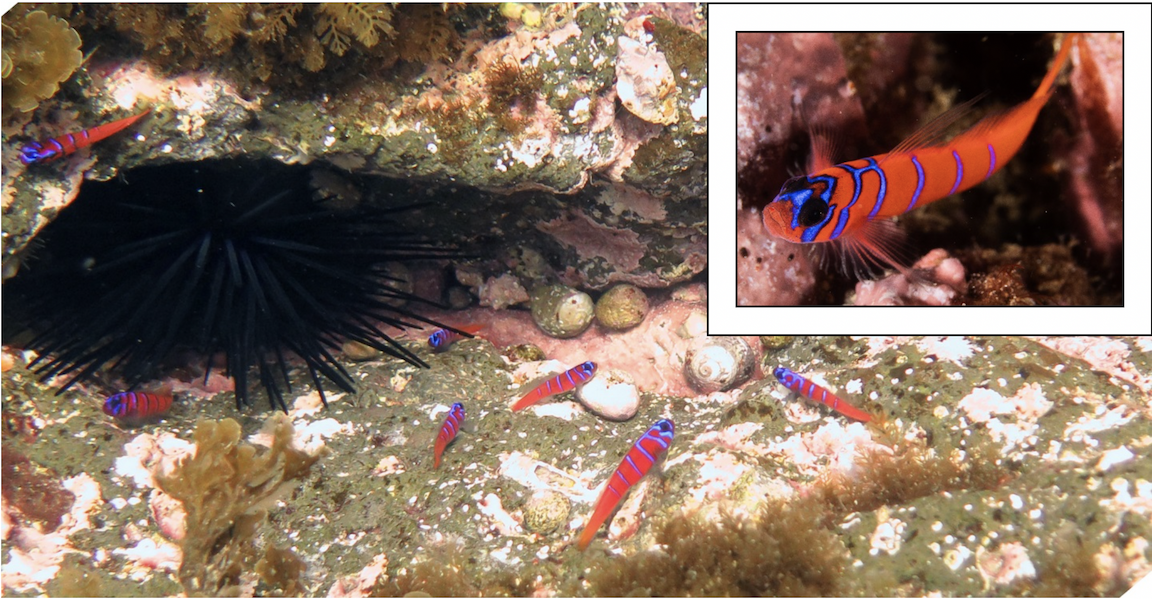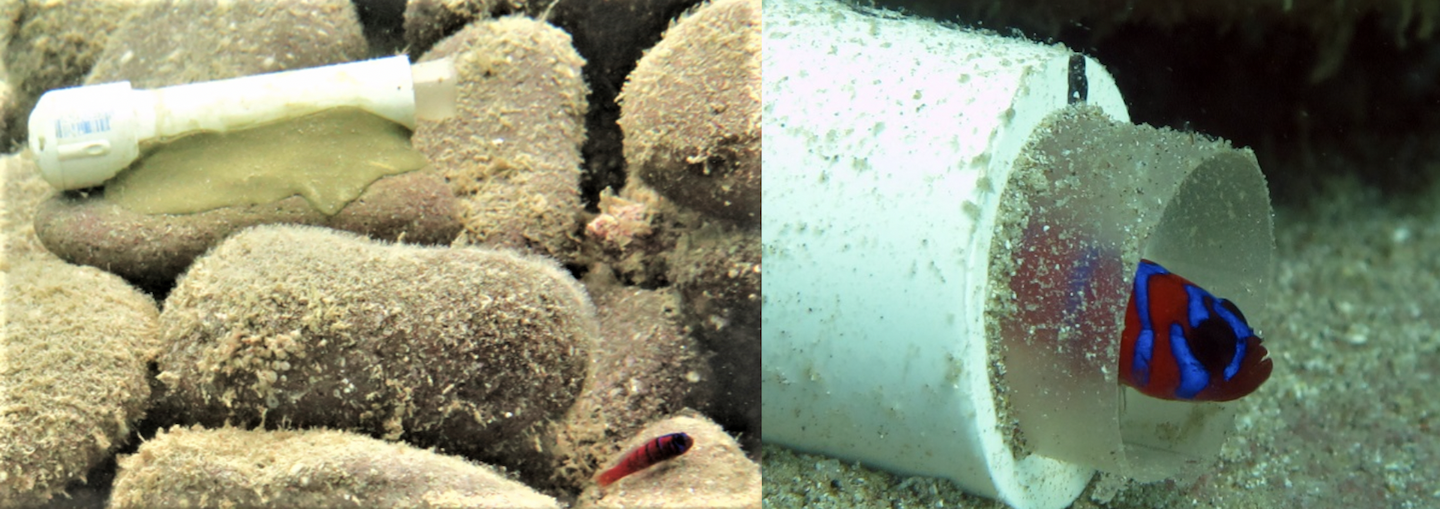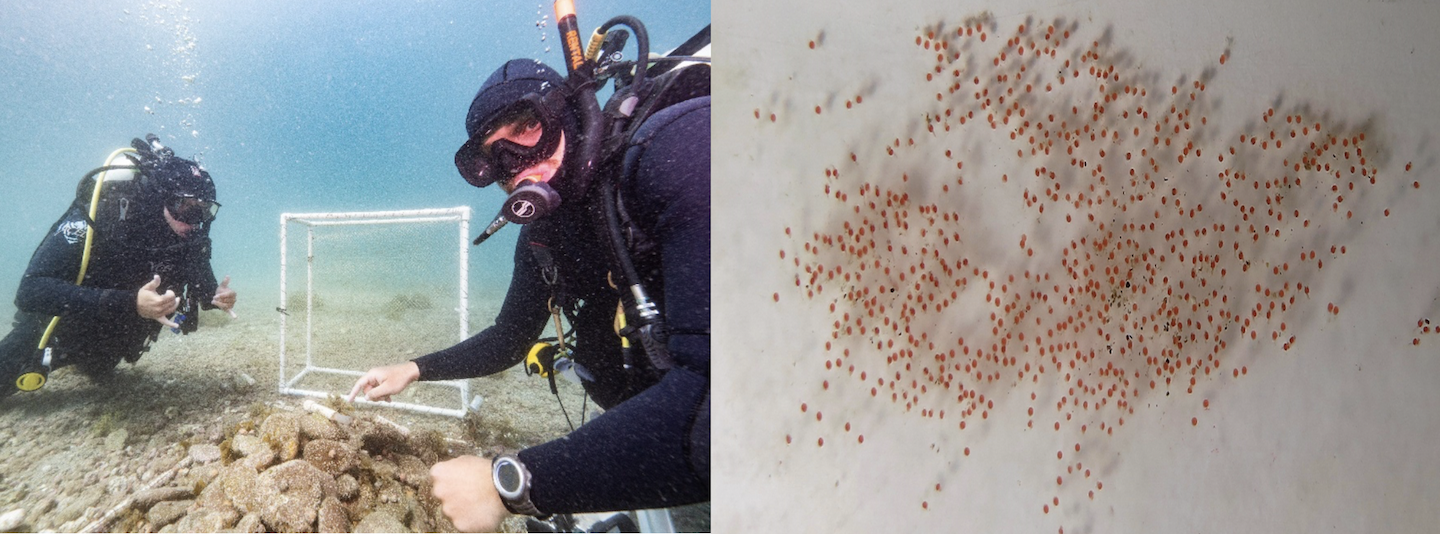By: George Jarvis
Hi everyone! My name is George and I am a Master’s student at California State University, Northridge. As a 2018 WMSC Graduate Fellow I have spent the entire summer studying the reproductive behavior of bluebanded gobies (Lythrypnus dalli). This species is highly abundant at Catalina Island, and female gobies reproduce by laying nests of eggs, which allows me to easily study their reproductive responses to environmental changes. Bluebanded gobies are constantly at risk of being eaten by a suite of natural predators, particularly the kelp bass (Paralabrax clathratus) and barred sand bass (Paralabrax nebulifer), and it has been shown that they alter their behavior in the presence of these predators. My research aims to assess the potential impacts of predation risk on bluebanded goby reproduction. Similarly to how we use mice as model organisms for studies on humans, I am using bluebanded gobies as a model organism to study reproductive responses in reef fishes.

A harem of bluebanded gobies in their natural reef environment (left, large) and a close-up of a male bluebanded goby (right, inset; photo credit: Maurice Roper). It’s not hard to see how this fish got its name!
In order to test the effects of predators on reproduction, I am running a manipulative experiment in Big Fisherman Cove at WMSC. I constructed a series of rocky reefs underwater, stocked them with populations of 20 bluebanded gobies, and covered them with three different types of cages to simulate risk levels perceived by the gobies: large exclusion cages (low-risk environment), small exclusion cages (medium-risk environment), and small cages with side panels removed to allow for full predator access (high-risk environment). I also stocked each reef with artificial goby nests (plastic tubes lined with acetate sheets), within which female gobies will lay eggs to later be fertilized and guarded by males. I perform biweekly surveys on SCUBA where I check each nest for eggs and photograph the nests when eggs are present. Later, I upload those nest photos, count all of the eggs, and then compare reproductive output among my different risk treatments.
As a WMSC Fellow I have had the unique opportunity to mentor a USC undergraduate, Hunter Ramo, during his summer Research Experience for Undergraduates (REU). This program is funded by the National Science Foundation, and undergraduates from all over the U.S. can apply to work with graduate student and faculty mentors on independent research projects. Hunter’s project aims to determine whether bluebanded gobies, which are a hermaphroditic fish (i.e. can change sex in response to environmental conditions) are more likely to change sex in high, medium, or low risk environments.

Scematic of the reef and caging treatments. Blue shading on caging indicates mesh netting to exclude predators, and white cylinders on each reef represent the artificial goby nests. Cartoons above show the physical separation between prey (gobies) and predators (kelp bass).
So far, our findings suggest that predation risk does not impact sex change, which could be due to the amount of time it takes for full sex change to occur. The REU program has allowed me to give Hunter a taste of what graduate research is all about, as well as improve my mentorship skills. I’m very proud of the work that we were able to do together this summer, and I highly recommend this program for undergraduates that are interested in research. For more info on the program, check out this link.

Artificial nest and goby nearby (left). Male guarding nest of eggs (right; photo credit: Scott Hamilton).
So what have we found so far? I still have a lot of egg counts awaiting me from this summer’s nest photos, but results from my previous field season suggest that gobies lay 33% fewer eggs in high-risk environments in comparison to medium and low-risk environments. Despite those differences in reproduction, however, it doesn’t appear to be driven by differences in behavior (e.g., foraging rates and/or time spent hiding from predators). This is very interesting to me, as I expected that behavioral differences would translate to differences in reproductive output. I hope to explore this further as I wrap up my thesis over the next few months. This research posits that predators are potentially having more of an impact on prey populations than we had previously assumed. Not only can predators affect prey reproduction through direct consumption of individuals, but they can also change prey behavior through risk effects. This is especially important information when we consider practices that alter predator abundances such as protection (e.g., in marine protected areas) or overfishing, and the cascading effects that those practices might have on other links in marine food webs.

Me pointing to a nest with eggs present, and dive buddy, Hunter, throwing up the double shakas in elation (left; photo credit: Maurice Roper). A typical goby nest photographed underwater; each circle is an individual egg (right).
The WMSC Fellowship has benefitted my thesis project immensely. I have gained invaluable field research, mentorship, and outreach experience during my time on the island this summer. The waterfront staff has been extremely helpful when it comes to day-to-day operations and troubleshooting, and the laboratory and administrative employees have been supportive and accommodating. Lastly, because WMSC is such an important hub for cutting-edge marine studies, I have been able to interact and foster professional relationships with other top scientists over the past few months. I am grateful for the privilege to conduct research at WMSC, and I suggest that graduate students interested in the fellowship check out this link for more info. Later on!

